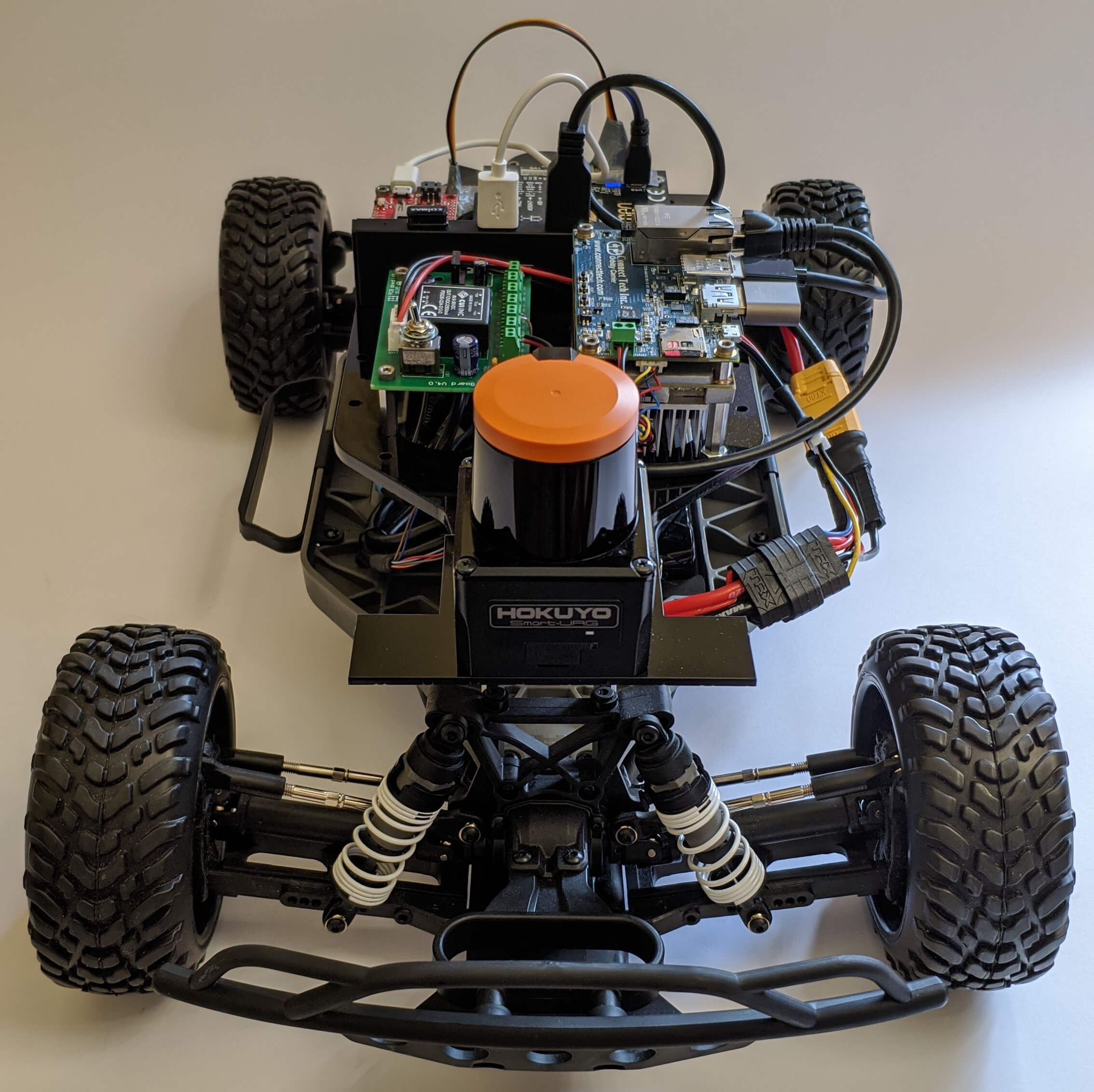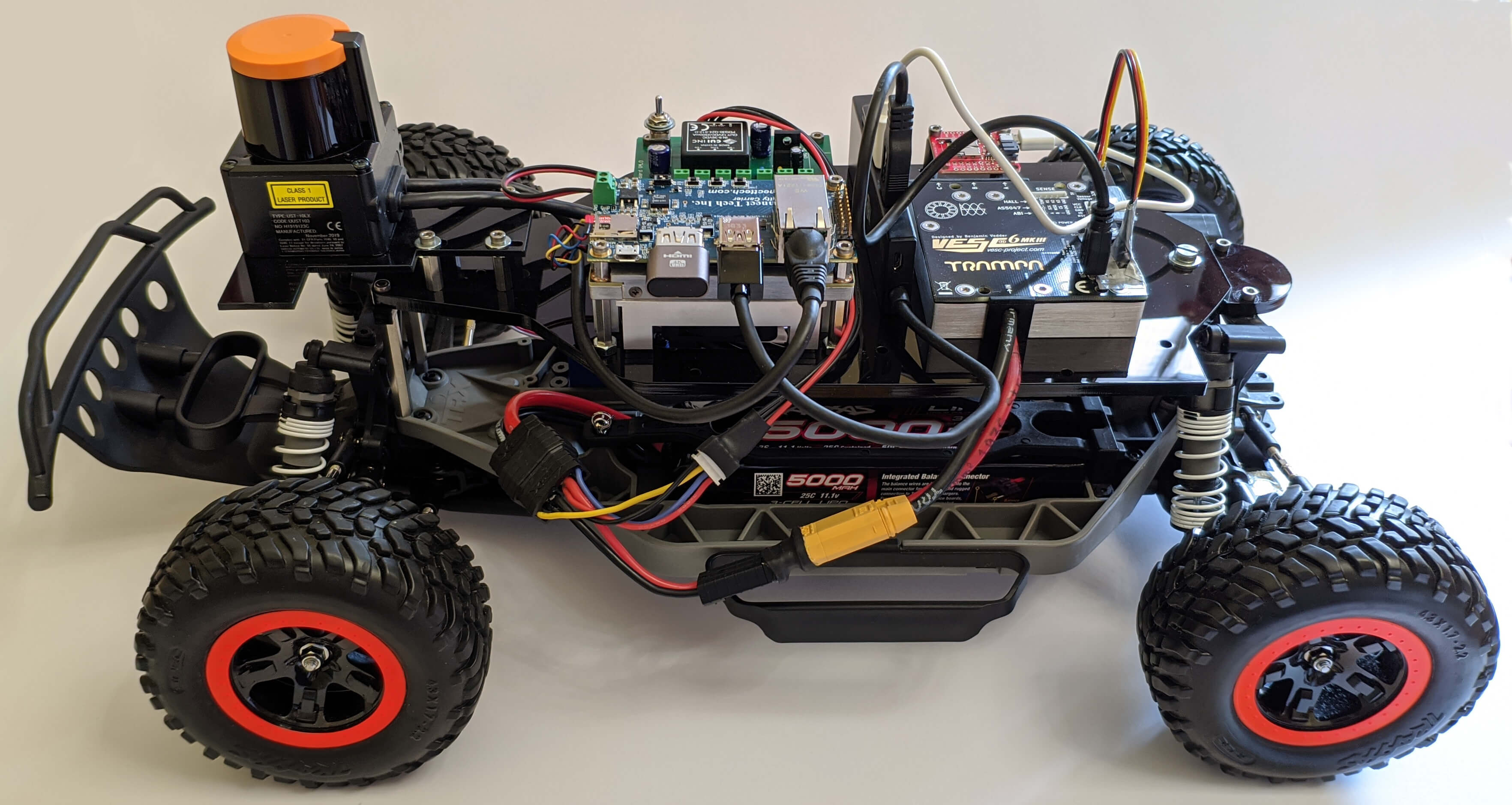[Paper] [Training on the physical car Video]
Implementation of DQN for autonomous racing using lidar data
It is designed to running on f1tenth cars
ROS is used to control the car motor, servo and acquire the lidar data
It can be used on both the real f1tenth car and on its simulator
The DQN implementation provides several techniques to improve performances like target network, replay buffer, state history, prioritized sampling. It has various parameters (see below) that one can modify to fit the specific environment. There are also various options to pre-process lidar data. One can use lidar data directly or represent them as images containing the environment borders. Velocity can be added to to the state
Model saving, replay buffer serialization, and tensorboard logging are provided
If you use this repo, please cite our paper [DOI].
@INPROCEEDINGS{9700730,
author={Bosello, Michael and Tse, Rita and Pau, Giovanni},
booktitle={2022 IEEE 19th Annual Consumer Communications Networking Conference (CCNC)},
title={Train in Austria, Race in Montecarlo: Generalized RL for Cross-Track F1<sup>tenth</sup> LIDAR-Based Races},
year={2022},
pages={290-298},
doi={10.1109/CCNC49033.2022.9700730}}
Abstract — Autonomous vehicles have received great attention in the last years, promising to impact a market worth billions. Nevertheless, the dream of fully autonomous cars has been delayed with current self-driving systems relying on complex processes coupled with supervised learning techniques. The deep reinforcement learning approach gives us newer possibilities to solve complex control tasks like the ones required by autonomous vehicles. It let the agent learn by interacting with the environment and from its mistakes. Unfortunately, RL is mainly applied in simulated environments, and transferring learning from simulations to the real world is a hard problem. In this paper, we use LIDAR data as input of a Deep Q-Network on a realistic 1/10 scale car prototype capable of performing training in real-time. The robot-driver learns how to run in race tracks by exploiting the experience gained through a mechanism of rewards that allow the agent to learn without human supervision. We provide a comparison of neural networks to find the best one for LIDAR data processing, two approaches to address the sim2real problem, and a detail of the performances of DQN in time-lap tasks for racing robots.
Three experiments have been performed (more details in the paper):
- NN comparison experiment: compares the performance of 1D CNN, 2D CNN, and fully-connected networks when used to detect LIDAR data
- Sim2real experiment, Training on the physical car: training the agent directly in the real world using real LIDAR data as input
- Sim2real experiment, Transfer learning: training the agent in the simulator and use the model in F1tenth car without any retraining thanks to our LIDAR pre-processing algorithm
- F1 racetracks experiment: demonstrates the race-performance, sample efficiency, and generalization capability of DQN through simulations in challenging F1 racetracks
Tensorboard logging and trained models of experiments (of both real and simulated car) are provided in the release section. Maps used in simulated experiments are available in the /map directory. If you want to use these maps, you must edit simulator.launch (see below) or copy the one provided in /map
F1 track maps came from this GitHub repo. You can find more maps here
Sim2real experiments videos:
-
Training on the physical car
A video showing the evolution of training and the evaluation of the real car in the sim2real experiment is available here
-
Transfer learning
Coming soon
-
Install ROS Melodic (desktop-full)
-
Install the dependencies
$ sudo apt-get install python3-pip python3-yaml$ pip3 install rospkg catkin_pkg$ sudo apt-get install ros-melodic-ackermann-msgs -
Optional dependencies
You need to install these packets only if you want to use the relative function
To use imitation learning through gamepad control (--gamepad=True):
$ pip3 install inputsTo visualize the images built from lidar data (lidar-to-image = True, show-image = True) you need opencv. In the Jetson you must build the arm64 version. In the simulator:
$ pip3 install opencv-pythonTo use compression of replay buffer (--compress-replay):
$ pip3 install blosc -
Setup the car or the simulator:
-
Real 1/10 scale car
Follow the four tutorials (Building the car, system configuration, installing firmware, driving the car) at https://f1tenth.org/build.html to build and setup the car
[optional] You need to add to the back of the car one or two IR sensors that are used to safely go backwards when an episode ends (because the hokuyo lidar covers only 270 degrees). Configure your pinout in the file car/sensors.py. The Orbitty Carrier has its own method to use gpio (i.e. bash commands). Check the numbers associated to the pins here and here. If you use the developer kit board, you have to implement the methods using Jetson.GPIO. If you use another board, find out how to use gpio and implement the methods. Alternatively, set backward seconds (in car_control.py) according to your track width, to avoid crashing.
-
Simulator
sudo apt-get install ros-melodic-map-server ros-melodic-joy$ mkdir -p simulator/src$ cd simulator/src$ git clone https://github.com/f1tenth/f1tenth_simulator.git$ cd ../$ catkin_make
-
-
Install tensorflow 2.x
-
If you are on a PC (i.e. simulator)
$ pip3 install tensorflow -
In the real car, you need to install tensorflow for Jetson with Cuda (installed via JetPack)
follow the tutorial for your specific Jetson (verify that it will install at least v2.1.x, otherwise execute the upgrade command)
-
-
Clone this repo
$ git clone https://github.com/MichaelBosello/f1tenth-RL.git
The parameters of the repo are configured for the simulator running on a PC with i7 processor (GPU is not used for Deep RL).
Check out the configurations for the real car and other envs at EXPERIMENT_SETTING.md
To let the control to the algorithm, you should change the priority of the control topics: edit the configuration of low_level_mux.yaml in f110_ws/f1tenth_system/racecar/racecar/config. Set priority of topic input/teleop to 1, input/safety to 2 and input/navigation to 3.
Launch the f1tenth system:
- Go to the working directory of the f1tenth system (/f110_ws)
$ source devel/setup.bash
$ roslaunch racecar teleop.launch
Run the RL algorithm:
- Go to the f1tenth-rl directory
$ python3 rl_car_driver.py
Launch the f1tenth simulator:
- Go to the working directory of the simulator (/simulator)
$ source devel/setup.bash
$ roslaunch f1tenth_simulator simulator.launch
Run the RL algorithm:
- Go to the f1tenth-rl directory
$ python3 rl_car_driver.py --simulator
-
The guide of the simulator is in the readme simulator/src/f1tenth_simulator/README/md
-
You may want to change the simulator options, check out simulator/src/f1tenth_simulator/params.yaml
-
If you want to change the track, you must edit simulator/src/f1tenth_simulator/launch/simulator.launch
Search for
<arg name="map" default="$(find f1tenth_simulator)/maps/levine.yaml"/>Change levine (the default map) with one map present in the folder simulator/src/f1tenth_simulator/maps
You can change several parameters when you run the program as command-line arguments. Use -h to see the argument help. You can check the list of arguments and change their default value in rl_car_driver.py
You can change the model size and architecture by changing the function __build_q_net in dqn.py. We provide some networks: a fully connected and a CNN1D. We give also the possibility to represent lidar data as images (black/white with env borders) and process them with a CNN2D
You can change the behavior of the actions in car_env.py. You can change the actions available to the agent by updating the action_set
Keep in mind that to use a trained model, you must have the same network size, the same input (number and dimension of frame), and the same number of actions
If you want to limit the car velocity, modify the constants in car/car_control.py
You can use the --model argument to load a trained model, e.g.:
python3 rl_car_driver.py --model=./run-real-car/models
The package car provides the interfaces to the car sensors (sensors.py) and actuators (car_control.py). It contains also a module that ensure the car will not (strongly) hit obstacles (safety_control.py). Finally, gamepad.py is used to retrieve gamepad commands during imitation learning.
car_env.py is the Reinforcement Learning environment.
rl_car_driver.py contains the training cycle. dqn.py includes the NN and the DQN algorithm.
state.py creates states by preprocesing data and stacking them to form a history. It also provides the compression to save RAM.
replay.py manage the samples and the replay buffer.
logging.py write (if enabled) to a CSV all the states, actions, and rewards of every step to build a dataset for offline use.
One can still use the dqn algorithm in alternative driving environments. You only need to implement your interfaces to the car sensors and actuators. To do so, implement your version of the files in the directory /car. You are also free to not use ROS at all.
At the beginning of the training, it could be useful to provide a demonstration of how to drive to the agent. You can help the agent by piloting the car using a joystick. The agent will learn through imitation learning by your demonstration, and then you can switch back to RL to refine and improve the behavior of the agent.
To enable the use of imitation learning, set --gamepad to True. The following instructions refer to our joystick, you need to check the corresponding buttons of your joystick and modify the file gamepad.py if needed. Check out the corresponding 'event.code' by pressing your joystick buttons and modify the strings accordingly
The agent starts in autonomous mode (RL). If you want to switch to manual control (i.e., imitation learning), press the button "A". Press it again to return to autonomous training (RL). Hold down "R2" to accelerate. Use the right analog stick to steer. "R2" works like a dead-man switch: if you release it, the car will stop and the agent will wait for your input.


